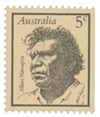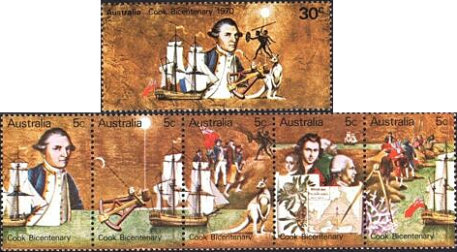History
Timeline results for
Found 1175 results for your search. Showing page 15 of 59.
1968
-
Geologist Jim Bowler discovers the remains of an Aboriginal woman in a dry lake bed of the Willandra Lakes World Heritage area in NSW. The remains are dated to be 40,000 years old and change the view of human history. They reveal a sophisticated culture and are the oldest evidence of homo sapiens outside Africa. The remains are later nicknamed "Mungo Lady".
-

Stamp celebrating Aboriginal artist Albert Namatjira. First named Aboriginal person honoured on an Australian stamp. Artist Albert Namatjira appears on the Famous Australians issue. He was also the first Aboriginal person to be accepted as a citizen of the Commonwealth in 1957.
1969
-
The New South Wales Aboriginal Welfare Board is abolished. The trust accounts are closed down and the remaining funds transferred to the Department of Youth and Community Services.
-
Aborigines Welfare Board in NSW is abolished. By 1969 all states have repealed the legislation allowing for the removal of Aboriginal children under the policy of ‘protection’. In the following years, Aboriginal and Islander Child Care Agencies (AICCAs) are set up to contest removal applications and provide alternatives to the removal of Indigenous children from their families.
-
Aborigines Advisory Council set up.
-
The federal government establishes the National Aboriginal Sports Foundation to help finance sports activities.
-
An Aboriginal delegation goes to New York and presents a statement on Australian Aboriginal people to the office of the UN Secretary-General.
-
Palawa man Andrew David Kennedy is elected as a Labor member to the Australian House of Representatives in the by-election for the seat of Bendigo. He holds the seat until his defeat at the 1972 federal election. Kennedy’s First Nations heritage was unknown when he entered parliament nor did he self-identify as Aboriginal at that time. For these reasons Neville Bonner is recorded as the first Aboriginal parliamentarian (in 1971). [1]
1970
-
In the 1970s, the Moree Boomerangs re-emerge after 30 years of abstinence from the rugby league. They can trace their playing days back to the 1940s. The team has included the likes of Phil Duke, Paul Roberts, Ewan McGrady, Dennis Kinchela and Mark Wright.
-
Some people from Maningrida in the Northern Territory returned to a preferred traditional way of life on their home estates. These estates were called ‘outstations’ and later ‘homeland centres’. By 1972 many people had moved back to their traditional homelands.
-
Aboriginal Medical Service formed in Redfern, Sydney.
-
Limited land lease rights are given to Aboriginal people on Northern Territory reserves.
-
A stamp issue for Australia's 200th anniversary of "first European contact" at the east coast centres around Captain Cook. A mini sheet issued by Australia Post annotates the third stamp of the series (which shows Aboriginal people in the top right corner) with "where he finds new people and strange animals", conveniently omitting conflict.

The Bicentenary issue put Aboriginal people into the far background. Can you spot them?
1971
-
Jack Charles and Bob Maza found the first Aboriginal theatre company Nindethana.
-
Larrakia people ‘sit-in’ at Bagot Road, Darwin as a protest against theft of their land.
-
Queensland Aborigines Act is passed, maintaining some legal restrictions for Aboriginal people living on reserves. Aboriginal cultural customs are banned and reading matter, mail, recreation, and marital and sexual relationships are censored. Their work and wage worth can be decreased and their movements recorded.
-
NSW Aboriginal Legal Service is formed, followed by Aboriginal pre-school, Black Theatre and the Aboriginal Housing Company.
-
Aboriginal player Evonne Goolagong wins Wimbledon Women’s Singles title.
-
Aboriginal people are counted in the national census for the first time.
-
Principals of schools in New South Wales are no longer able to exclude Aboriginal children because of home conditions or community opposition.
References
View article sources (1)
[1]
'Indigenous Australian parliamentarians in federal and state/territory parliaments: a quick guide', Parliament of Australia 15/6/2021, available at www.aph.gov.au/About_Parliament/Parliamentary_Departments/Parliamentary_Library/pubs/rp/rp2021/Quick_Guides/IndigenousParliamentarians2021

